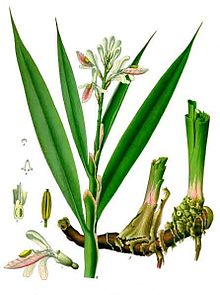Alpinia officinarum

Alpinia officinarum, known as lesser galangal, is a plant in the ginger family, cultivated in Southeast Asia. It originated in China, where its name ultimately derives. It can grow 1.5 to 2 m high,[1] with long leaves and reddish-white flowers. The rhizomes, known as galangal, are valued for their sweet spicy flavor and aromatic scent. These are used throughout Asia in curries and perfumes, and were previously used widely in Europe.[citation needed] They are also used as an herbal remedy.
The genus is named for Prospero Alpini, a 17th-century Italian botanist who specialized in exotic plants. The word “galangal” comes from the Arabic form of a Chinese word for the plant, “高良薑” (“gou-loeng-goeng” in Cantonese, “gao-liang-jiang” in Mandarin).[2][3] In Tamil it is known as a “சிற்றரத்தை or சித்தரத்தை” (“see-tha-ra-thai), widely used in Siddha Medicine and in culinaries.
This herbaceous plant can grow up to 2 metres in height. The leaves are lanceolate (long and thin), and the flowers are white with streaks of red, growing from a spike at the top. The plant’s rhizomes, the part known as galangal, are thin and tough, and they are the principal reason the plant is cultivated. They have orange flesh with a brown coating, and have an aromatic odor and a sweet flavor. These are smaller than greater galangal which have a stronger peppery pine-like bite that is lacking in the sweeter rhizomes of lesser galangal.[2][3]
